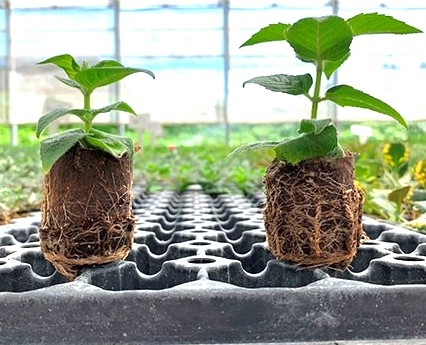Mycorrhizae means fungus (myco) root (rhizae). These root-associated fungi predate the evolution of terrestrial plants, and the partnership with mycorrhizal fungi facilitated the establishment of plant on earth. Mycorrhizae form symbiotic associations with more than 70% of land plants across a broad range of terrestrial ecosystems. Plants supplies mycorrhizae with photo-assimilated carbon in exchange for nutrients and water. This is the definition of a perfect relationship whereby the two sides support each other and have a personal interest at maintaining their counterpart well-being for survival. Once mycorrhizae colonize the host plant, its mycelium can grow over large distances to neighboring plants connecting them together by a common network. This extension of the root network allows plants to acquire water and nutrients (especially nitrogen and phosphorus) far beyond its root zone, rendering plants more resilient to drought and nutrient deficiency. The ability of mycorrhizae to form this underground web also enables the connected plant to communicate with each other through chemical signals and exchange water and nutrients. For example, in forest ecosystems, saplings rely on nutrients and carbon supply from older trees sent through the mycorrhizal network. This underground mycorrhizal web has also great physical properties because they improve the soil structure by forming stable soil aggregates thereby limiting erosion and leaching of nutrients.
Several studies have highlighted the instrumental role of these beneficial fungi in several cropping systems, including tree crops. In citrus for instance, they have been shown to delay diseases caused by soilborne pathogens such as Fusarium and Phytophthora. We also think that these fungi play a key role in the citrus Huanglongbing (HLB) pathosystem by protecting trees from suffering root loss. Results from our recent survey in Florida showed that healthy trees were more frequently associated with a biodiverse mycorrhizal population whereas declining trees rarely formed a symbiotic association with mycorrhizae and were frequently infected with Phytophthora and Fusarium. We think that tree decline is due not just to HLB infection in the aerial portions of the tree but also to large sectors of the root community shifting toward microbes that engage in pathogenic and saprophytic relationships with the host.
|
Plant root system with and without mycorrhizae Source: https://www.nurserymag.com/article/mycorrhizal-applications-brand-spotlight/ |
If you are a grower, how do you ensure that trees in your orchard have mycorrhizae? Well, this is where the challenge resides because the intricate relationship between the fungus and its host is not easy to replicate on command in the field. Several commercial products are available to use but it is unclear how efficient exogenous applications of mycorrhiza inocula are. Nurseries have increasingly used commercial inoculum, and data showed that it is a great way to improve productivity for some annual plants (see figure). But science is still lacking to evaluate if the symbiotic relationship can last for trees after planting and how it translates to the orchard life with respect to tree performance and longevity. An efficient way to foster relationship between plants and mycorrhizae is to adopt mycorrhizae-friendly practices. In general, low input agriculture systems that rely on soil fertility and microbial activity are conducive to mycorrhizae. One of our recent studies compared organic and conventional farming practices in California citrus orchards and showed that the former has much higher mycorrhizae biodiversity and more frequent association with trees than the later. Mycorrhizae are sensitive to conventional agrochemicals. Foliar fungicide application runoffs and glyphosate treatments have been shown to negatively affect these fungi. Similarly, high input of inorganic nitrogen and phosphorous are detrimental to mycorrhizae. In general, practices that increase organic matter in soils (compost, manure), planting of cover crops, low to moderate dose of N and P organic fertilizers and avoidance of soil disturbance (tillage) favor mycorrhizae establishment and biodiversity. Yet, a lot more needs to be accomplished before we can fully exploit this powerful underground resource.
